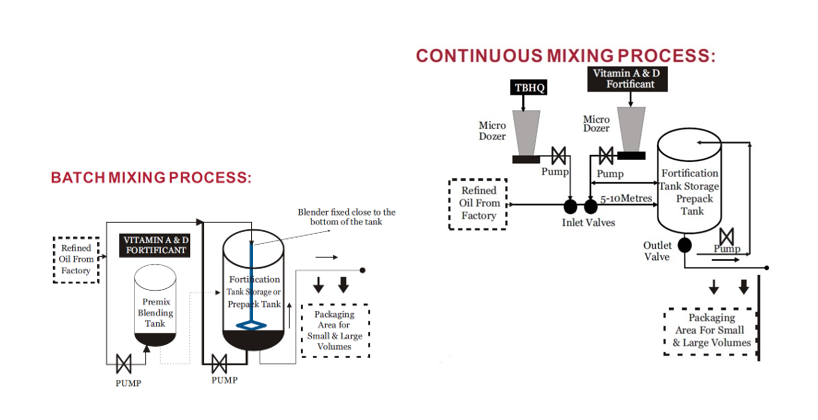Fortification
“The practice of deliberately increasing the content of an essential micronutrient, i.e. vitamins and minerals (including trace elements) in a food irrespective of whether the nutrients were originally in the food before processing or not, so as to improve the nutritional quality of the food supply and to provide a public health benefit with minimal risk to health". – WHO/FAO

Food fortification helps to bridge the gap between the recommended dietary allowances and the actual intake of various micronutrients. Food fortification is recognized both by WHO as well as the National Nutrition Mission (POSHAN Abhiyaan), Government of India (GOI), as one of the most cost-effective methods to reduce micronutrient malnutrition. It has been instrumental in lowering the incidence of micronutrient deficiencies amongst all population groups across the globe.
It also has the added advantage of not requiring any behaviour modification or compliance at the end-user level, which is expected in strategies such as micronutrient supplementation. Fortification of multiple foods that are consumed by various population groups and are either distributed through the public funded programmes like the Public Distribution System (PDS), Integrated Child Development Service (ICDS), Mid-Day Meals (MDM) scheme and/or also sold through the open market commercial channels, offers an excellent opportunity to provide micronutrients on a sustained basis.
Oil Fortification
India is the fourth largest edible oil market in the world. Oil has mass penetration (about 99% of households in India) across geographies and groups of population with a per capita consumption of 15Kg per year consequently leading to an annual consumption of 23 -25 Million Ton. The practice of fortification began in India as early as 1953 when Vanaspati was fortified with vitamin A under legislation SRO-2103.
Oil acts as an excellence vehicle for adding nutrients to the diet as consumption of oil among all the population groups is reasonable high. Recent National Nutrition Monitoring Bureau (NNMB) survey and a report of the expert group of ICMR in 2012 has stated that India has a very high burden of Vitamin A and D deficiencies, amongst both young children and adults, particularly in urban areas, which are physically less active and have very limited exposure to sunlight. Oil acts as a safe and cost effect means to address such nutritional deficiencies

Wheat Flour Fortification
Wheat flour is one of the most commonly consumed staple food in India with an average per capita per day consumption of wheat flour ranging between 150-300 grams in India. Wheat flour is thus a suitable food vehicle for fortifying with Iron, Folic Acid and Vitamin B12.

Moreover, during milling of wheat grain into wheat flour, a large proportion of folic acid, iron, vitamin B6, thiamine, riboflavin, niacin present in whole-wheat kernels are lost. This decreases the nutritive value of the flour. Thus, nutrients may be added to flour in amounts equal to those present before processing to make fortified flour.
There is adequate evidence that fortification of wheat flour is effective, simple and an inexpensive strategy for providing important vitamins and minerals to large segments of the population without requiring change in food habits or dietary pattern or measures to address the problem of compliance.

